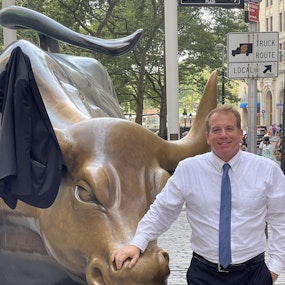
www.johnspenningtonjr.com In Episode 471 of the podcast, hosted by Daniel Martinez, guest John S. Pennington Jr. recounts his entrepreneurial journey from "Blue Jeans To Billions," detailing his innovative approach to business right out of college in 1989. Leveraging the fall of the Soviet Union, Pennington and his partners capitalized on the high demand for Levi 501 jeans in Eastern Europe, buying them cheaply in the United States and selling them at a significant markup. The story highlights Pennington's strategic problem-solving skills, as he navigated challenges with thrift stores and competitors by directly engaging with the public and building a robust supply chain that outpaced competitors. The business thrived for about nine years until changes in fashion, currency valuations, and geopolitical sentiments in the late '90s led to its decline, showcasing the importance of adaptability and market awareness in entrepreneurship. Introduction to the Guest and Topic (0:00-0:21): Daniel Martinez introduces John S. Pennington Jr., highlighting his return to the show to discuss a deal breakdown and share a cool, interesting story about his first business venture involving Levi 501 jeans and the opportunities following the fall of the Soviet Union. The Initial Business Model and Challenge (0:47-2:06): Pennington shares the inception of his business in 1989, focusing on collecting and exporting Levi 501 jeans to Eastern Europe, and how he and his partners initially sourced their inventory from thrift stores across the Western United States. He discusses the challenge when thrift stores raised prices after learning the business model. Strategic Shift and Expansion (2:41-4:18): Faced with competition and thrift stores selling to others, Pennington describes how they pivoted to buying directly from the public, advertising in newspapers, and setting up buying events. This strategic shift not only resolved their inventory issues but significantly expanded their operation across the West, eventually establishing a network of 650 locations that supplied jeans to their business. Conclusion of the Business (6:42-7:35): Pennington reflects on the factors leading to the end of the business around 1999, including changing fashion trends towards baggy jeans, the rising value of the dollar, and shifting sentiments in Europe post-Gulf War. Despite the decline, he shares his fond memories of the venture and the lessons learned in problem-solving and adaptability in business. Text 📱 210-972-1842 Text 📔 "Course" to learn how to make 6 figures on one land deal. Text ✴️ "Hive" to get added to weekly meetings. Text 🍎 "Apple" to schedule a 1-on-1 call with Anthony & Daniel. Text 🛬 "Land" to join The Million Dollar Land Mastermind 🔍 Need Inbound Real Estate Leads. https://www.hiveleads.io/ 🔍 Follow Us on YouTube https://www.youtube.com/channel/UCbulcrC4WbOy5Fzu0eWzNVQ/?sub_confirmation=1 🔍 Follow Us on Instagram https://www.instagram.com/hivemindcrm/ 🔍 Check Out https://www.hivemindcrm.io/ 🔍 Check Out Our Land Mastermind https://www.milliondollarlandmastermind.com/landmastermind 🔍 Pick Up All Event Recordings here. https://thehiveislive.com/recording 🔍 Follow Us on TikTok https://www.tiktok.com/@hivemindcrm?lang=en 📍Join the FB Group https://www.facebook.com/groups/137799891494707 📍 Check us at Join Us! https://thehiveislive.com/ Help support the show. https://anchor.fm/hivmindcrm/support
--- Support this podcast: https://podcasters.spotify.com/pod/show/hivemindcrm/support

Daniel Esteban Martinez
Host/ Ceo/ Speaker
I have been an entrepreneur since 2018. I come from a regular home just like most people. My dad worked on the roads in the Chicago area for over 30 years. He always taught me to work with my brain, instead of my body. Your body can only take so much abuse. I learned so much from my father. He always pushed me to work smarter and not harder.
I have owned and operated a trucking business for 2 years. I started learning real estate in 2019. Fell into the Data & Skiptracing business in 2020. My partner Anthony & I started Hivemind in 2021.
I have done a ton of different jobs coming up from painting, to door-to-door sales, telemarketing, truck driving, and loading trailers. What I learned most is that I want to stay in the digital business space. The leverage you can have delivering digital products to the marketplace can yield limitless possibilites.
I started The List Guys in 2020. It is a data and skiptracing service. We provide seller and buyers list nationwide. My clients have been getting great results and I am proud to help people killing it.
I started the Hive in 2021 with my partner Anthony Gaona. It is a real estate and business mastermind. It also comes with a all in one CRM, that can host unlimited websites and users.
Starting the Hivemind has been an amazing journey so far. Seeing one of our users make his 6 figure month in June 2021 leveraging our software, I know there will be plenty more to come!

John S. Pennington Jr.
co-founder - $28 B family of funds
About John S. Pennington Jr.
In 2008 – John S. Pennington Jr. co-founded a family of private equity funds that by the time of his
retirement – grew to well over $28 billion of Assets Under Management (AUM). During his tenure and
before obtaining partner emeritus status, he served on the board of directors, held signing authority on
over 1,200 bank accounts as the deputy chief financial officer (DCFO), was president of over 100
corporations, was the Anti-Money Laundering Officer (AMLO) for all companywide feeder funds located
in the Cayman Islands and oversaw all U.S. Securities and Exchange Commission regulatory
requirements as chief compliance officer (CCO). In 2021 – he retired with the company listed on the
NYSE.
In 2004 and 2007 – John co-founded Bridge Loan Capital Fund I and II.
In 1988 – John earned a degree from the University of Utah in economics. He and his wife, Jane, have
three sons, two daughters-in-law with five grandchildren and have been married for over thirty-eight
years.








